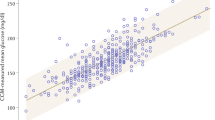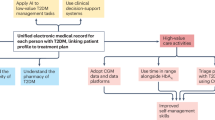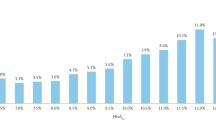Abstract
The benefits of good glycaemic control in both type I and type II diabetes mellitus are undoubtedly proven. Most national bodies have recommended glycaemic targets, with an HbA1c to achieve between 6.5 and 7.5%. However, it is well known that even in clinical trials, and routinely in clinical practice, the majority of patients fail to achieve optimal glycaemic control. The reasons for this failure are complex and multifactorial. Healthcare providers often delay the initiation and intensification of insulin unnecessarily. This stems from a fear of causing hypoglycaemia or weight gain in patients, from doubts about patients’ self-care abilities and/or from inadequate resources to provide the necessary structured education to support patient self-management. Patients may be poorly adherent to treatment advice—particularly behavioural aspects such as self-monitoring, diet and exercise—although this may itself derive from inadequate access to effective diabetes education. There is, however, a limit to what can be achieved with existing exogenous insulin therapies due to their imperfect pharmacokinetic and pharmacodynamic profiles. Prominent among these imperfections is the problem of variability of effect from injection to injection with basal insulin formulations. Improvements in this area should benefit control and tolerability.
This is a preview of subscription content, access via your institution
Access options
Subscribe to this journal
Receive 12 print issues and online access
$259.00 per year
only $21.58 per issue
Buy this article
- Purchase on Springer Link
- Instant access to full article PDF
Prices may be subject to local taxes which are calculated during checkout





Similar content being viewed by others
References
DCCT Research group. The absence of a glycemic threshold for the development of long-term complications: the perspective of the Diabetes Control and Complications Trial. Diabetes 1996; 45: 1289–1298.
UK Prospective Diabetes Study (UKPDS) Group. Intensive blood-glucose control with sulphonylureas or insulin compared with conventional treatment and risk of complications in patients with type 2 diabetes (UKPDS 33). Lancet 1998; 352: 837–853.
Stratton IM, Adler AI, Neil HA, Matthews DR, Manley SE, Cull CA, Hadden D, Turner RC, Holman RR . Association of glycaemia with macrovascular and microvascular complications of type 2 diabetes (UKPDS 35): prospective observational study. BMJ 2000; 321: 405–412.
American Diabetes Association. clinical practice recommendations, 1999 Diabetes Care 1999; 22: S1–S114.
A desktop guide to Type 2 diabetes mellitus. European Diabetes Policy Group 1999. Diabet Med 1999; 16: 716–730.
DCCT Research Group. The effect of intensive treatment of diabetes on the development and progression of long-term complications in insulin-dependent diabetes mellitus. N Engl J Med 1993; 329: 977–986.
DCCT Research group. Implementation of treatment protocols in the Diabetes Control and Complications Trial. Diabetes Care 1995; 18: 361–376.
Pieber TR, Brunner GA, Schnedl WJ, Schattenberg S, Kaufmann P, Krejs GJ . Evaluation of a structured outpatient group education program for intensive insulin therapy. Diabetes Care 1995; 18: 625–630.
Gaede P, Vedel P, Larsen N, Jensen GV, Parving HH, Pedersen O . Multifactorial intervention and cardiovascular disease in patients with type 2 diabetes. N Engl J Med 2003; 348: 383–393.
Glasgow RE, McCaul KD, Schafer LC . Self-care behaviors and glycemic control in type I diabetes. J Chronic Dis 1987; 40: 399–412.
Gordon D, Wilson M, Paterson KR, Semple CG . Audit of multiple insulin injection regimens in a large outpatient diabetic population. Diabetes Res Clin Pract 1992; 17: 145–150.
David S, Abou Amara S, Colin C, Perret du Cray MH, Thivolet C . Evaluation of the hospital management of insulin-dependent diabetics. Presse Med 1997; 26: 1666–1670.
Deckers S, Hermans MP, Buysschaert M . Therapy, glycaemic control and complications in type 1 diabetic patients: results from a single centre cohort of 465 subjects. Acta Clin Belg 2001; 56: 289–296.
Craig ME, Handelsman P, Donaghue KC, Chan A, Blades B, Laina R, Bradford D, Middlehurst A, Ambler G, Verge CF, Crock P, Moore P, Silink M, NSW/ACT HbA(1c) Study Group. Predictors of glycaemic control and hypoglycaemia in children and adolescents with type 1 diabetes from NSW and the ACT. Med J Aust 2002; 177: 235–238.
Vanelli M, Chiarelli F, Chiari G, Tumini S . Relationship between metabolic control and quality of life in adolescents with type 1 diabetes. Report from two Italian centres for the management of diabetes in childhood. Acta Biomed Ateneo Parmense 2003; 74: 13–17.
Holl RW, Swift PG, Mortensen HB, Lynggaard H, Hougaard P, Aanstoot HJ, Chiarelli F, Daneman D, Danne T, Dorchy H, Garandeau P, Greene S, Hoey HM, Kaprio EA, Kocova M, Martul P, Matsuura N, Robertson KJ, Schoenle EJ, Sovik O, Tsou RM, Vanelli M, Aman J . Insulin injection regimens and metabolic control in an international survey of adolescents with type 1 diabetes over 3 years: results from the Hvidore study group. Eur J Pediatr 2003; 162: 22–29.
New JP, Hollis S, Campbell F, McDowell D, Burns E, Dornan TL, Young RJ . Measuring clinical performance outcomes from diabetes information systems: an observational study. Diabetologia 2000; 43: 836–843.
McFarlane SI, Jacober SJ, Winer N, Kaur J, Castro JP, Wui MA, Gliwa A, Von Gizycki H, Sowers JR . Control of cardiovascular risk factors in patients with diabetes and hypertension at urban academic medical centers. Diabetes Care 2002; 25: 718–723.
UK Prospective Diabetes Study Group. UK prospective diabetes study 16. Overview of 6 years’ therapy of type II diabetes: a progressive disease. Diabetes 1995; 44: 1249–1258.
Gonder-Frederick L, Cox D, Kovatchev B, Julian D, Clarke W . The psychosocial impact of severe hypoglycemic episodes on spouses of patients with IDDM. Diabetes Care 1997; 20: 1543–1546.
Gonder-Frederick LA, Clarke WL, Cox DJ . The emotional, social, and behavioral implications of insulin-induced hypoglycemia. Semin Clin Neuropsychiatry 1997; 2: 57–65.
Korytkowski M . When oral agents fail: practical barriers to starting insulin. Int J Obes Relat Metab Disord 2002; 26: S18–S24.
Davis S, Alonso MD . Hypoglycemia as a barrier to glycemic control. J Diabetes Complications 2004; 18: 60–68.
Hepburn DA, MacLeod KM, Pell AC, Scougal IJ, Frier BM . Frequency and symptoms of hypoglycaemia experienced by patients with type 2 diabetes treated with insulin. Diabet Med 1993; 10: 231–237.
McNally P, Fitch M, Nelson G . Patients with type 2 diabetes mellitus have lower rates of nocturnal hypoglycaemia on biphasic insulin as part (BIAsp.30) than on biphasic human insulin-30 (BHI-30): data from the reach study. Diabet Med 2004; 21: A52.
The DCCT Research Group. Weight gain associated with intensive therapy in the diabetes control and complications trial. Diabetes Care 1988; 11: 567–573.
The DCCT Research Group. Influence of intensive diabetes treatment on body weight and composition of adults with type 1 diabetes in the Diabetes Control and Complications Trial. Diabetes Care 2001; 24: 1711–1721.
Purnell JQ, Hokanson JE, Marcovina SM, Steffes MW, Cleary PA, Brunzell JD . Effect of excessive weight gain with intensive therapy of type 1 diabetes on lipid levels and blood pressure: results from the DCCT. Diabetes Control and Complications Trial. JAMA 1998; 280: 140–146.
The DAWN (Diabetes Attitudes, Wishes and Needs) Study. Pract Diab Int 2002; 19: 22–24a.
Hayward RA, Manning WG, Kaplan SH, Wagner EH, Greenfield S . Starting insulin therapy in patients with type 2 diabetes: effectiveness, complications, and resource utilization. JAMA 1997; 278: 1663–1669.
de Sonnaville JJ, Snoek FJ, Colly LP, Deville W, Wijkel D, Heine RJ . Well-being and symptoms in relation to insulin therapy in type 2 diabetes. Diabetes Care 1998; 21: 919–924.
de Grauw WJ, van de Lisdonk EH, van Gerwen WH, van den Hoogen HJ, van Weel C . Insulin therapy in poorly controlled type 2 diabetic patients: does it affect quality of life? Br J Gen Pract 2001; 51: 527–532.
Rosendal H, Vondeling H, de Witte LP, Hutubessy RC, van Beekum WT, Heine RJ . Initiating insulin therapy in patients with diabetes mellitus type 2: in a transmural setting is at least as effective as in an outpatient setting; a retrospective study with a 4-year follow-up. Ned Tijdschr Geneeskd 2002; 146: 166–171.
Vahatalo M, Ronnemaa T, Viikari J . Factors affecting the efficacy of starting insulin treatment in Type 2 diabetic patients. A retrospective evaluation. Scand J Prim Health Care 2003; 21: 230–236.
Schifferdecker E, Schmidt K, Boehm BO, Schatz H . Long-term compliance of intensified insulin therapy. Diabetes Res Clin Pract 1994; 23: 17–23.
Writing Team for the Diabetes Control Complications Trial/Epidemiology of Diabetes Interventions Complications Research Group. Effect of intensive therapy on the microvascular complications of type 1 diabetes mellitus. JAMA 2002; 287: 2563–2569.
Knight G, Boulton AJM, Drury J, Ward JD . Long term glycaemic control by alternative regimens in a feasibility study of continous subcutaneous insulin infusion. Diab Res 1986; 3: 355–358.
Möhrle W, Richter WO, Schwandt P . Intensivierte konventionelle Insulintherapie. Langzeiter-folge und Gründe Für das Versagen dieses Therapiekonzeptes. Dtsch. Med Wochenschr 1989; 114: 899–902.
Howorka K . Funkionelle, nahe-normoglykämische Insulin substitution. Springer-Verlag: Berlin, Heidelberg, New York.
Reichard P, Nilsson BY, Rosenquist U . The effect of long term intensified insulin treatment on the development of microvascular complications of diabetes mellitus. N Engl J Med 1993; 329: 304–309.
DAFNE Study Group. Training in flexible, intensive insulin management to enable dietary freedom in people with type 1 diabetes: dose adjustment for normal eating (DAFNE) randomised controlled trial. BMJ 2002; 325: 746.
Shearer A, Bagust A, Sanderson D, Heller S, Roberts S . Cost-effectiveness of flexible intensive insulin management to enable dietary freedom in people with Type 1 diabetes in the UK. Diabet Med 2004; 21: 460–467.
Norris SL, Engelgau MM, Narayan KM . Effectiveness of self-management training in type 2 diabetes: a systematic review of randomized controlled trials. Diabetes Care 2001; 24: 561–587.
NICE Guidance on the use of patient education models for diabetes 2003. http://www.nice.org.uk/pdf/60Patienteducationmodelsfullguidance.pdf.
Ramchandani N, Cantey-Kiser JM, Alter CA, Brink SJ, Yeager SD, Tamborlane WV, Chipkin SR . Self-reported factors that affect glycemic control in college students with type 1 diabetes. Diabetes Educ 2000; 26: 656–666.
Snoek FJ . Breaking the barriers to optimal glycaemic control—what physicians need to know from patients’ perspectives. Int J Clin Pract Suppl 2002; 129: 80–84.
Pramming S, Thorsteinsson B, Bendtson I, Binder C . Symptomatic hypoglycaemia in 411 type 1 diabetic patients. Diabet Med 1991; 8: 217–222.
Kyngas H . Compliance of adolescents with diabetes. J Pediatr Nurs 2000; 15: 260–267.
Peel E, Parry O, Douglas M, Lawton J . Blood glucose self-monitoring in non-insulin-treated type 2 diabetes: a qualitative study of patients' perspectives. Br J Gen Pract 2004; 54: 183–188.
Morris AD, Boyle DI, McMahon AD, Greene SA, MacDonald TM, Newton RW . Adherence to insulin treatment, glycaemic control, and ketoacidosis in insulin-dependent diabetes mellitus. The DARTS/MEMO Collaboration. Diabetes Audit and Research in Tayside Scotland. Medicines Monitoring Unit. Lancet 1997; 350: 1505–1510.
Morris AD . The reality of type 2 diabetes treatment today. Int J Clin Pract 2001; 55: 598.
Grant RW, Devita NG, Singer DE, Meigs JB . Polypharmacy and medication adherence in patients with type 2 diabetes. Diabetes Care 2003; 26: 1408–1412.
Saudek CD . Novel forms of insulin delivery. Endocrinol Metab Clin N Am 1997; 26: 599–610.
Binder C, Lauritzen T, Faber O, Pramming S . Insulin pharmacokinetics. Diabetes Care 1984; 7: 188–199.
Heinemann L . Variability of insulin absorption and insulin action. Diabetes Technol Ther 2002; 4: 673–682.
Chen JW, Christiansen JS, Lauritzen T . Limitations to subcutaneous insulin administration in type 1 diabetes. Diabetes Obes Metab 2003; 5: 223–233.
Heise T, Nosek L, Biilmann Rønn B, Endahl L, Heinemann L, Kapitza C, Draeger E . Lower within-subject variability of insulin Detemir in comparison to NPH insulin and insulin Glargine in people with type 1 diabetes. Diabetes 2004; 53: 1614–1620.
Lindholm A . New insulins in the treatment of diabetes mellitus. Best Pract Res Clin Gastroenterol 2002; 16: 475–492.
Home PD, Lindholm A, Riis A, European Insulin Aspart Study Group. Insulin aspart vs human insulin in the management of long-term blood glucose control in Type 1 diabetes mellitus a randomized controlled trial. Diabet Med 2000; 17: 762–770.
Russell-Jones D . Insulin detemir: improving the predictability of glycaemic control. Int J Obes 2004; 28 (Suppl 2): S29–S34.
Heller S, Kurtzhals P, Verge D, Lindholm A . Insulin aspart: promising early results borne out in clinical practice. Expert Opin Pharmacother 2002; 3: 183–195.
Author information
Authors and Affiliations
Rights and permissions
About this article
Cite this article
Davies, M. The reality of glycaemic control in insulin treated diabetes: defining the clinical challenges. Int J Obes 28 (Suppl 2), S14–S22 (2004). https://doi.org/10.1038/sj.ijo.0802745
Published:
Issue Date:
DOI: https://doi.org/10.1038/sj.ijo.0802745
Keywords
This article is cited by
-
Magnitude and predictors of poor glycemic control in patients with diabetes at Jimma Medical Center, Ethiopia
Scientific Reports (2023)
-
Glycemic Control and its Predictors among Adult Diabetic Patients attending Mettu Karl Referral Hospital, Southwest Ethiopia: A Prospective Observational Study
Diabetes Therapy (2020)
-
Determinants of poor glycemic control among adult patients with type 2 diabetes mellitus in Jimma University Medical Center, Jimma zone, south west Ethiopia: a case control study
BMC Endocrine Disorders (2019)
-
A Review of the Safety and Adverse Event Profile of the Fixed-Ratio Combination of Insulin Glargine and Lixisenatide
Diabetes Therapy (2019)
-
Glycaemic control for people with type 2 diabetes in Saudi Arabia – an urgent need for a review of management plan
BMC Endocrine Disorders (2018)



